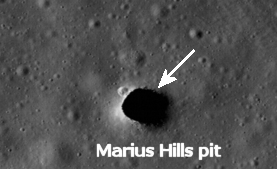
July Editorial
Lunar vulcanism and volcanic tunnels

July Editorial
Lunar vulcanism and volcanic tunnels
|
Most researchers agree that the Earth’s Moon is about 4.5 billion years old - that’s about 50 million years younger than the rest of the solar system. One theory is that the moon was formed when another planet (more or less the size of Mars) hit the molten ball of rock that was the Earth at that time. Some of the debris from that collision was flew into space where it eventually re-formed as a solid mass - our present Moon.
|
Although this part of the Moon’s history is generally accepted, other areas are still very uncertain. One of these is the question of when there was volcanic activity on the moon, how long that activity lasted for, and how much of it there was. The first studies of lunar volcanic rocks were made possible when samples were brought to the Earth by astronauts during the Apollo missions of 1969 to 1972. | |
|
These studies suggested that most volcanic activity on the moon happened around 3.9 billion years ago. Then, in 1999, a massive 30-pound (13.5-kilogram) moon rock was found in the Kalahari Desert in Botswana. Examination of this lunar meteorite showed that it is made of basalt. Basalt is a common rock that forms from cooling magma and is a telltale sign of volcanic activity. Researchers believe that this lunar meteorite (known as Kalahari 009) rock landed on Earth 200 to 300 years ago after a voyage which started when an asteroid strike on the moon sent the rock flying into space. So when was the lunar basalt formed? The authors of a research paper (Kentaro Terada, et al, Nature 450, 849-852) examined small grains of two phosphate-containing minerals - apatite and merrillite inside the rock. They combined this with Uranium-lead (U-Pb) dating. Once magma solidifies, the uranium in the rock breaks down and slowly converts into lead. By measuring the ratio of uranium and lead in the rock, the researchers estimated its age as 4.35 +/- 0.15 billion years. Therefore meteorite Kalahari 009 suggests that volcanic activity on the Moon started soon after the moon was formed - which about 0.5 billion years earlier than previously thought. Most vulcanism on the Moon probably happened around 3.8-3.9 billion years ago, and mostly stopped around 3 billion years ago. Scientists estimate the age of a lunar landscape by counting the craters blasted into its surface by meteors. The older a region, the more craters it has. However most research had focused on the side of the Moon which can be observed through telescopes from Earth. There was no way of studying the dark side of the Moon other than photographs of earlier space missions. Then at the end of 2007 the Japanese lunar orbiter ‘Kaguya’ sent extensive images of the dark side of the Moon. Using these images, researchers were able to manually count craters. The dark side of the moon is smoother than expected, suggesting that volcanic activity happened much more recently than previously thought. The new estimate is that the Moon was volcanically active as recently as 2.5 million years ago. In December 2009 Kaguya sent images of a large hole in a sinuous rille in the Marius Hills region, a volcanic area on the lunar nearside. Sinuous rilles form in two different ways: as open lava channels and/or as lava tubes, many of which subsequently collapse. Because the Marius Hills pit is in the middle of a sinuous rille, it probably represents a collapse in the roof of a lava tube. The pit itself may have been caused by a meteorite impact that punched through the lava tube roof. The hole is about 65 meters in diameter and using a series of images with dim sunlight reflected from the site at different angles it appears that the hole forms a pit to around 80 to 88 meters deep. The area around the hole is covered by a thin (20 to 25 m) lava sheet, which may help protect the lava tube from collapse after a meteorite bombardment. What is interesting about this structure is that such a deep hole should provide shelter from Lunar radiation and extreme temperatures. Researchers from the the Japanese space agency JAXA and their colleagues from NASA believe that such a lava tube may well be a potential site for a Lunar base station, or at least an outpost from which other exploratory missions can be organised. | |
| _______________________________ | ||||
| Home | | | Shopping | | | Database |
© Biscuit Software 2004-2015
All rights reserved